How to Discover Shopify Trending Products for Your E-Commerce Success
Are you ready to boost your Shopify store's success by digging into trending products? Finding products that align with current consumer interests can significantly enhance your sales and brand visibility. Rapid changes in market trends can directly impact your business performance and market position if captured and responded to timely.
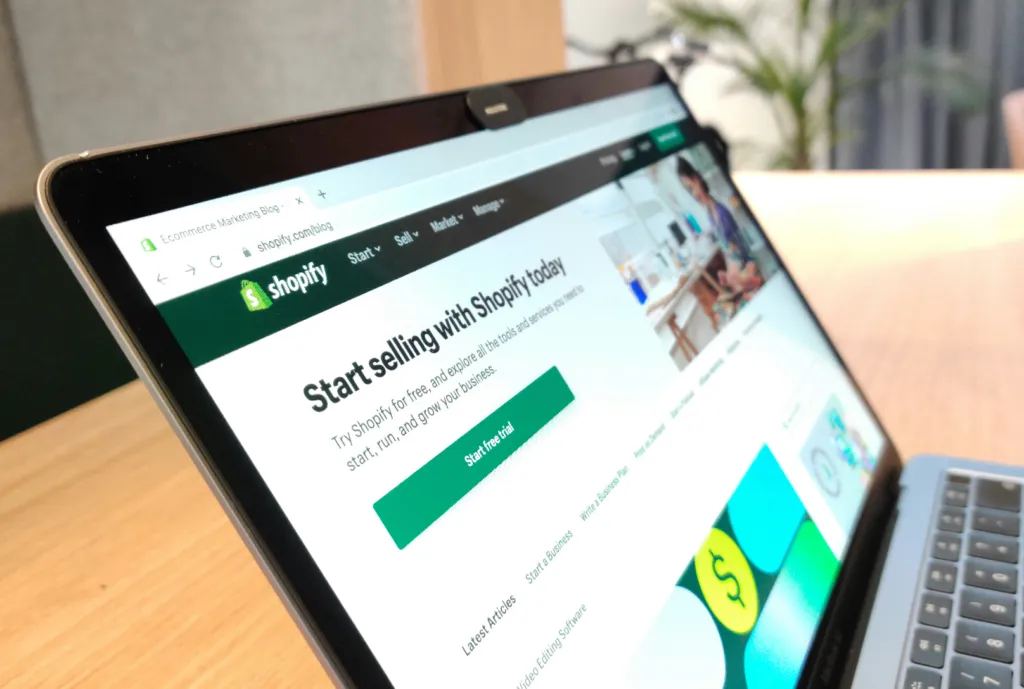
In this blog post, we will provide a series of proven strategies and practical tools to help you identify hot products that can attract consumer attention and drive sales growth. We will also explore how to optimize your product selection using market data analysis, consumer behavior insights, and competitor dynamics. By employing these methods, you can ensure that your Shopify store remains at the forefront of market trends, seizing every opportunity for growth and success.
Understanding the Importance of Trending Products
Why focus on Shopify trending products?
Trending products are the cornerstone of a successful e-commerce strategy. They not only attract more traffic but also pique customer interest and generate discussions around your brand. By accurately pinpointing and leveraging these trending products, you can quickly boost sales and brand exposure during peak periods of consumer interest.
By leveraging trends, you're not just following the market but anticipating market movements, thus gaining a competitive edge. This strategy can not only increase sales in the short term but also continue to attract and retain consumer interest, creating long-term growth and a stable customer base for your business. Moreover, continuously updating your products to align with market trends can also help establish an innovative and forward-looking image for your brand, further deepening consumer brand loyalty and trust. These are key factors in driving e-commerce success through smart utilization of Shopify trending products.
Using Shopify’s Tools
Explore Shopify Analytics
Shopify provides a robust set of built-in analytics tools that offer valuable data support revealing customer search habits and preferences. Using these tools, you can delve deep into what types of products your customers are most interested in, which keywords frequently appear in searches, and which products have the highest click-through and conversion rates. These analytics can directly guide your inventory decisions, helping you make smarter choices about which products to stock more of and which to reduce or even discontinue.
Furthermore, you can monitor search trends and customer behavior patterns to forecast future sales trends. For instance, if a certain type of product has been increasing in search volume over the past few months, this could indicate an upcoming peak in sales. Accordingly, you can adjust your purchasing plans and marketing strategies to ensure that your store can meet the increased demand.
Additionally, these analytics tools allow you to segment the market and identify the specific needs of different customer groups, thus achieving more precise market positioning and personalized marketing. By regularly reviewing this data, you can continuously optimize your product line and marketing efforts, maintaining the competitiveness and market sensitivity of your business.
Leverage the Shopify App Store
The Shopify App Store offers a vast array of apps specifically designed to help merchants identify and track trending products. For example, tools like "Trend Scanner" and "Hot Products" can provide real-time data and analysis on the current hot products in your niche market. These apps, by collecting and analyzing extensive market sales data, can help you understand which products are currently winning consumer favor.
One of the main benefits of using these tools is their ease of operation and the immediacy of the data provided. You can see in real-time which products are performing well in the global market or in specific regions, allowing you to make quick adjustments to your inventory or marketing strategies. Additionally, these apps often include trend forecasting features, which not only display current popular items but can also predict future trending products, essential for keeping your store ahead of market competition.
Further, these apps typically offer detailed data analysis and user-friendly interfaces, enabling even those without deep data analysis skills to easily interpret and utilize this data. For instance, you can observe changes in search volume for a particular product, sales growth rates, and consumer reviews and feedback, all of which are crucial for formulating effective business strategies.
Finally, many of these apps can seamlessly integrate with other Shopify features, such as inventory management and marketing automation, making your operations more efficient. This means you can not only identify hot products in the market but also automatically adjust your marketing activities and inventory strategies upon discovering these trends, maximizing sales potential and profits.
Conducting Market Research
Follow Industry Leaders and Influencers
Following industry leaders and influencers within your market is one of the key strategies for identifying and leveraging Shopify trending products. These leaders and influencers are often pioneers of brand and product trends, and their choices and recommendations can greatly influence consumer purchasing decisions. By closely monitoring their activities, you can gain early signals about which products might become the next hot items.
Industry leaders and influencers typically share their latest discoveries and recommendations on social media platforms like Instagram, X(twitter), YouTube, or TikTok. Their posts, videos, or live streams often attract significant attention and interaction, which are powerful indicators of a product's potential popularity. Additionally, they might participate in or host industry events and seminars, offering opportunities to learn about the latest market trends and network building.
For example, YouTube blogger Blogilates, with 9.75 million followers on YouTube, posts a video about a hoodie that receives over 2 million likes. This hoodie could potentially become a winning product.
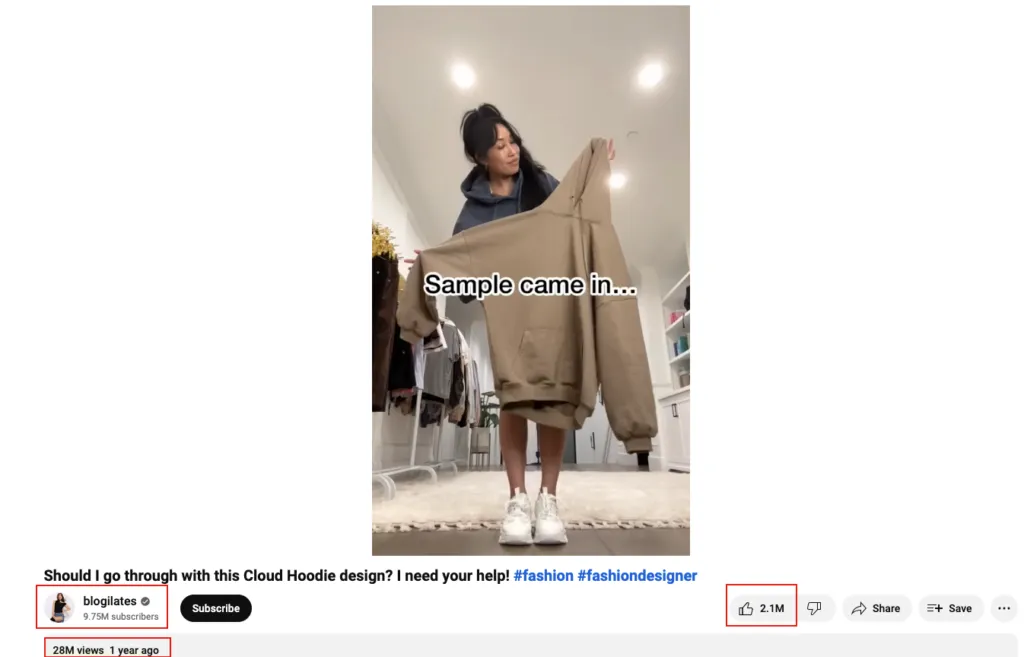
To fully utilize this information, you can set up social media monitoring to regularly check the postings of these leaders and influencers, paying attention to the brands and products they mention. Additionally, analyzing the audience's feedback on their content, such as comments, likes, and shares, can help you assess a product's market acceptance and potential heat.
Further, you can establish collaborations with these industry leaders and influencers to directly obtain information about trending products. For instance, by inviting them to try your products and share feedback, or by collaborating to develop customized products, not only can you increase product exposure, but you can also enhance your brand's credibility and appeal through their reputation and influence.
In summary, by actively following and utilizing the resources of industry leaders and influencers, you can foresee and respond to market dynamics earlier, thereby maintaining a leading position in a competitive market.
Engage on Social Media Platforms
Platforms like Instagram, Pinterest, and TikTok are ideal places to discover emerging trends. These platforms have millions of users sharing and discussing the latest products, styles, and ideas daily, making them valuable resources for capturing and leveraging current popular products.
Firstly, Instagram is renowned for its high-impact visual content and is a hot spot for showcasing and discovering new products. By following relevant industry tags, such as #fashiontrends or #techgadgets, you can quickly learn which types of products are attracting attention. Additionally, Instagram's stories and live features allow merchants to interact with consumers in real time, not only increasing brand visibility but also helping to promote new products directly.
Pinterest is unique in its role as a tool for inspiration and wish lists. Users on Pinterest look for and save products and ideas they are interested in, providing merchants with a way to identify potential Shopify trending products by analyzing which boards or images are frequently saved.
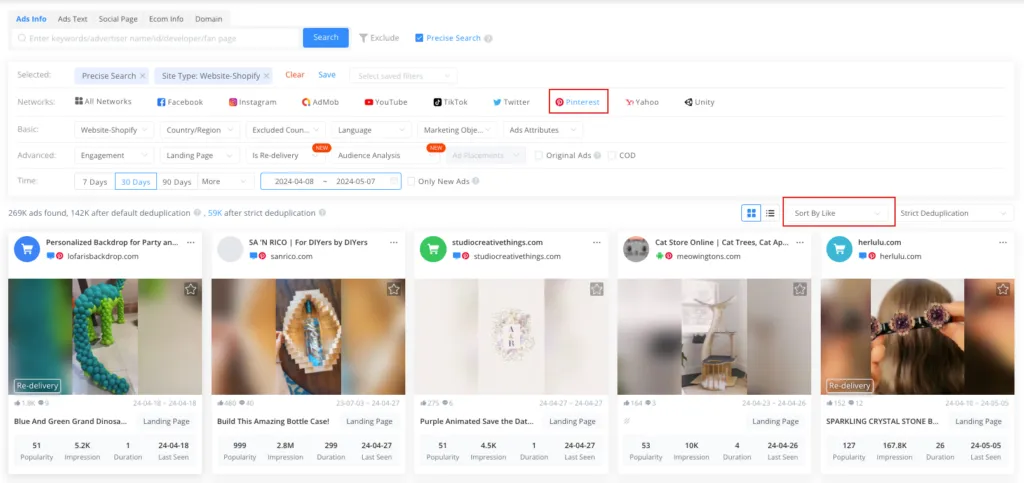
On BigSpy, you can select Pinterest and sort by likes for a short period, allowing you to filter results for products that are popular on Pinterest in the short term.
TikTok, as a platform dominated by younger users, has become a powerhouse for setting trends. Through short videos, users can quickly share and spread information about novel products. Merchants can promote their products by participating in popular challenges or topics or by collaborating with influential creators.
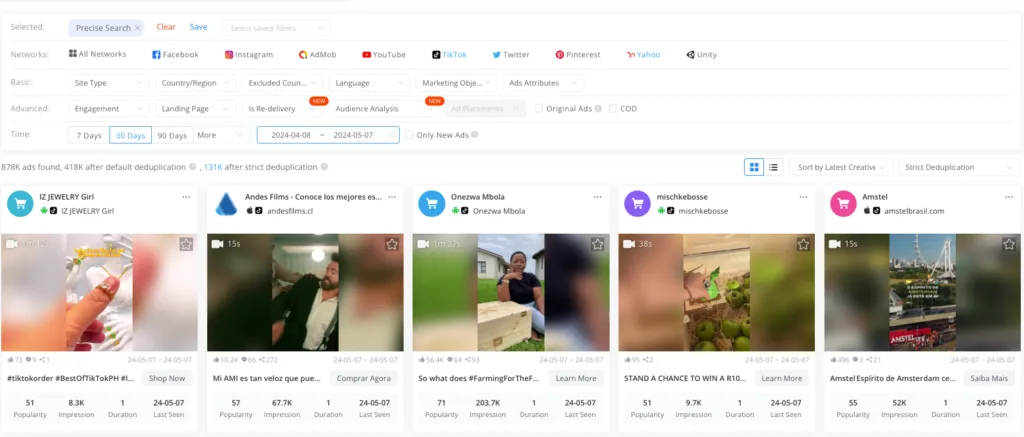
You can also filter TikTok on BigSpy, and I recommend sorting by the latest creative, so you can analyze the latest product types on TikTok and their creative types. Based on your extensive experience, you can initially save some ads that you think are not bad, and after a period, you can look at their data again to help you determine whether this product is a trending product.
To effectively utilize these platforms, it's advisable to set up specific monitoring mechanisms to track keywords and topics related to your business. Using social media monitoring tools like Hootsuite or BigSpy can help you keep up with consumer interest and reactions to certain products in real-time. Additionally, participating in comments and discussions, as well as utilizing these platforms' advertising products to promote your goods, are effective strategies for increasing exposure and sales.
By incorporating these strategies into your market research toolkit, you can more effectively identify which products are popular on social media and consider incorporating these trending products or similar ones into your Shopify store to attract more customers and boost sales performance.
Analyzing Competitor Success
Monitor Your Competitors
Keeping an eye on your competitors' websites and social media is a crucial step in understanding market trends and adjusting your business strategy. This strategy can not only reveal which products are performing well among competitors but also help you discover potentially underutilized market opportunities.
Firstly, by regularly visiting competitors' websites, you can observe their product displays, special promotions, and any new product launches. Additionally, monitoring their social media activities can provide direct information about which products are popular, often reflected through the interaction rates of products, such as likes, shares, and comments.
Furthermore, if you want to quickly understand what products your competitors are heavily promoting and how those products are performing, I would directly recommend you search for your competitors' website names on BigSpy, as shown below. The search results are all the ads placed by this website, not only clearly understanding what the core products of this website are, but also for the data-good materials, you can analyze the advertising creative itself and the time period of the placement to optimize your product placement strategy.
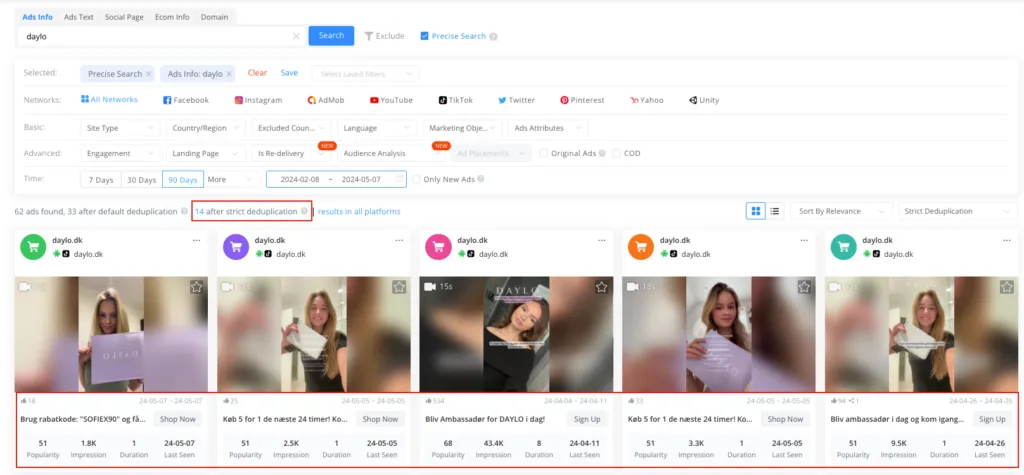
Further, advanced tools like SEMrush and Ahrefs can provide deep insights into your competitors' website performance and traffic sources. These tools can help you understand your competitors' SEO strategies, such as the keywords they use, their most traffic-generating pages, and the rankings of these pages. With this data, you can adjust your keyword strategy, optimize SEO, and enhance the visibility and attractiveness of your own website.
Tools like SEMrush and Ahrefs also offer backlink analysis, allowing you to see which external websites link to your competitors, which is very valuable for building your own link-building strategy. Additionally, the market exploration features of these tools can show you your competitors' market share and their performance in different regions and among different user groups.
In summary, by combining website and social media monitoring with advanced analysis tools, you can not only gain insights into which products are performing well among competitors but also gain insights into overall industry market trends, allowing you to adjust your market strategy and product line to enhance competitiveness and market position.
Listening to Your Customers
Customer Feedback
Collecting and analyzing customer feedback is a key process for understanding your target market's needs, directly telling you what your audience wants, what aspects you are doing well in, and what areas need improvement. By effectively using surveys, feedback forms, and customer reviews, you can gather valuable customer preference information, thereby optimizing your products and services, and enhancing customer satisfaction, and loyalty.
Firstly, surveys are an excellent tool for collecting specific and quantitative data. You can send surveys directly to your customers via email marketing, social media, or your website, asking them for their opinions on your products or services and what new products or improvements they would like to see. To increase response rates, you might consider offering incentives, such as discounts or future shopping benefits.
Feedback forms can be embedded in your website, especially after the purchase process is completed or during customer service interactions. These feedback forms should be concise and easy to fill out while ensuring useful feedback is collected. For example, you can ask customers about their satisfaction with the shopping experience or their evaluation of product quality.
Customer reviews are another key source of feedback. Encouraging customers to leave reviews after purchases not only provides direct feedback about the products but also increases the trust of new customers. For e-commerce, positive customer reviews can significantly improve conversion rates, while timely responses to negative reviews, showing that you value the customer experience, can convert dissatisfied customers and increase brand loyalty.
Additionally, using data analysis tools to systematically analyze this feedback data is also very important. By identifying common patterns of complaints and praises, you can more accurately understand customer needs and expectations. These insights can help you adjust the direction of product development, improve customer service strategies, and formulate more targeted marketing campaigns.
In summary, by comprehensively using surveys, feedback forms, and customer reviews to collect and analyze customer feedback, you not only deepen your understanding of the market but also better position your brand and products in a competitive market, ultimately driving business growth and success.
Trying and Innovating
Testing Different Products
Do not be afraid to try and adjust your product supply, which is an important strategy for maintaining competitiveness and meeting market demand. Using A/B testing can help you scientifically assess which products resonate most with your target audience, allowing you to make informed inventory and marketing decisions based on actual data.
A/B testing, also known as split testing, is a method of comparing two or more versions to determine which one is more effective. In the case of product supply, you can choose two similar products with different key features and promote them under similar market conditions to see which one performs better. This could involve comparing different designs, price points, or marketing messages to see which factors are most appealing to consumers.
For example, you could promote two different colors of the same product in the same sales channel over the same period, collecting and analyzing which color sells better. Similarly, you could also test the impact of different price points to see how higher or lower prices affect sales.
Another key aspect of implementing A/B testing is ensuring the validity of the tests. This means having a sufficient sample size and testing duration to obtain statistically significant data. Additionally, changing only one variable at a time can help you accurately identify which specific factor influenced consumer purchasing decisions.
Based on the results of the A/B testing, you can more precisely adjust your inventory levels and product strategies. If one version clearly outperforms another, you might choose to increase the inventory of that version, or even consider phasing out the poorly performing version. This method not only helps you optimize your product mix but also improves the ROI of your marketing activities, ultimately enhancing overall sales and customer satisfaction.
By continually testing and learning, you can better understand market dynamics and customer preferences, keeping your business flexible and responsive to market changes, thereby maintaining a leading position in a highly competitive market.
With the strategies and methods outlined above, I believe that through your learning and continuous experimentation, you will gradually find your own path to identifying Shopify trending products. Accordingly, you can also use these trending products to boost the sales of your Shopify store.













